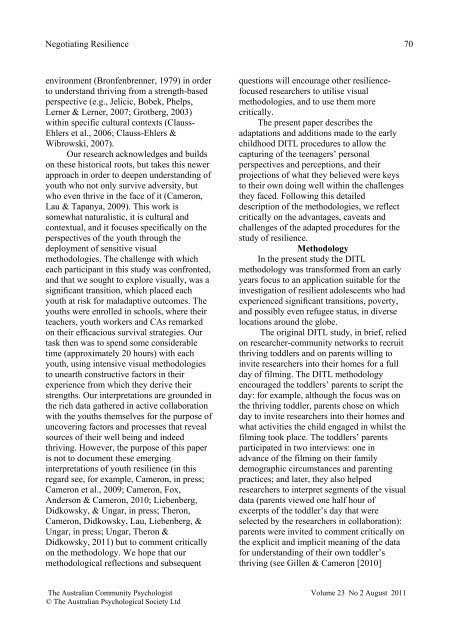The Australian Community Psychologist - APS Member Groups
The Australian Community Psychologist - APS Member Groups
The Australian Community Psychologist - APS Member Groups
You also want an ePaper? Increase the reach of your titles
YUMPU automatically turns print PDFs into web optimized ePapers that Google loves.
Negotiating Resilience<br />
70<br />
environment (Bronfenbrenner, 1979) in order<br />
to understand thriving from a strength-based<br />
perspective (e.g., Jelicic, Bobek, Phelps,<br />
Lerner & Lerner, 2007; Grotberg, 2003)<br />
within specific cultural contexts (Clauss-<br />
Ehlers et al., 2006; Clauss-Ehlers &<br />
Wibrowski, 2007).<br />
Our research acknowledges and builds<br />
on these historical roots, but takes this newer<br />
approach in order to deepen understanding of<br />
youth who not only survive adversity, but<br />
who even thrive in the face of it (Cameron,<br />
Lau & Tapanya, 2009). This work is<br />
somewhat naturalistic, it is cultural and<br />
contextual, and it focuses specifically on the<br />
perspectives of the youth through the<br />
deployment of sensitive visual<br />
methodologies. <strong>The</strong> challenge with which<br />
each participant in this study was confronted,<br />
and that we sought to explore visually, was a<br />
significant transition, which placed each<br />
youth at risk for maladaptive outcomes. <strong>The</strong><br />
youths were enrolled in schools, where their<br />
teachers, youth workers and CAs remarked<br />
on their efficacious survival strategies. Our<br />
task then was to spend some considerable<br />
time (approximately 20 hours) with each<br />
youth, using intensive visual methodologies<br />
to unearth constructive factors in their<br />
experience from which they derive their<br />
strengths. Our interpretations are grounded in<br />
the rich data gathered in active collaboration<br />
with the youths themselves for the purpose of<br />
uncovering factors and processes that reveal<br />
sources of their well being and indeed<br />
thriving. However, the purpose of this paper<br />
is not to document these emerging<br />
interpretations of youth resilience (in this<br />
regard see, for example, Cameron, in press;<br />
Cameron et al., 2009; Cameron, Fox,<br />
Anderson & Cameron, 2010; Liebenberg,<br />
Didkowsky, & Ungar, in press; <strong>The</strong>ron,<br />
Cameron, Didkowsky, Lau, Liebenberg, &<br />
Ungar, in press; Ungar, <strong>The</strong>ron &<br />
Didkowsky, 2011) but to comment critically<br />
on the methodology. We hope that our<br />
methodological reflections and subsequent<br />
questions will encourage other resiliencefocused<br />
researchers to utilise visual<br />
methodologies, and to use them more<br />
critically.<br />
<strong>The</strong> present paper describes the<br />
adaptations and additions made to the early<br />
childhood DITL procedures to allow the<br />
capturing of the teenagers’ personal<br />
perspectives and perceptions, and their<br />
projections of what they believed were keys<br />
to their own doing well within the challenges<br />
they faced. Following this detailed<br />
description of the methodologies, we reflect<br />
critically on the advantages, caveats and<br />
challenges of the adapted procedures for the<br />
study of resilience.<br />
Methodology<br />
In the present study the DITL<br />
methodology was transformed from an early<br />
years focus to an application suitable for the<br />
investigation of resilient adolescents who had<br />
experienced significant transitions, poverty,<br />
and possibly even refugee status, in diverse<br />
locations around the globe.<br />
<strong>The</strong> original DITL study, in brief, relied<br />
on researcher-community networks to recruit<br />
thriving toddlers and on parents willing to<br />
invite researchers into their homes for a full<br />
day of filming. <strong>The</strong> DITL methodology<br />
encouraged the toddlers’ parents to script the<br />
day: for example, although the focus was on<br />
the thriving toddler, parents chose on which<br />
day to invite researchers into their homes and<br />
what activities the child engaged in whilst the<br />
filming took place. <strong>The</strong> toddlers’ parents<br />
participated in two interviews: one in<br />
advance of the filming on their family<br />
demographic circumstances and parenting<br />
practices; and later, they also helped<br />
researchers to interpret segments of the visual<br />
data (parents viewed one half hour of<br />
excerpts of the toddler’s day that were<br />
selected by the researchers in collaboration):<br />
parents were invited to comment critically on<br />
the explicit and implicit meaning of the data<br />
for understanding of their own toddler’s<br />
thriving (see Gillen & Cameron [2010]<br />
<strong>The</strong> <strong>Australian</strong> <strong>Community</strong> <strong>Psychologist</strong> Volume 23 No 2 August 2011<br />
© <strong>The</strong> <strong>Australian</strong> Psychological Society Ltd

















